Mercedes and McLaren take the Bull by the horns: British, Hungarian and Belgian GP report
In a month of blistering F1 action and controversy, Mark Hughes mops his brow to give us his round-up of three memorable races
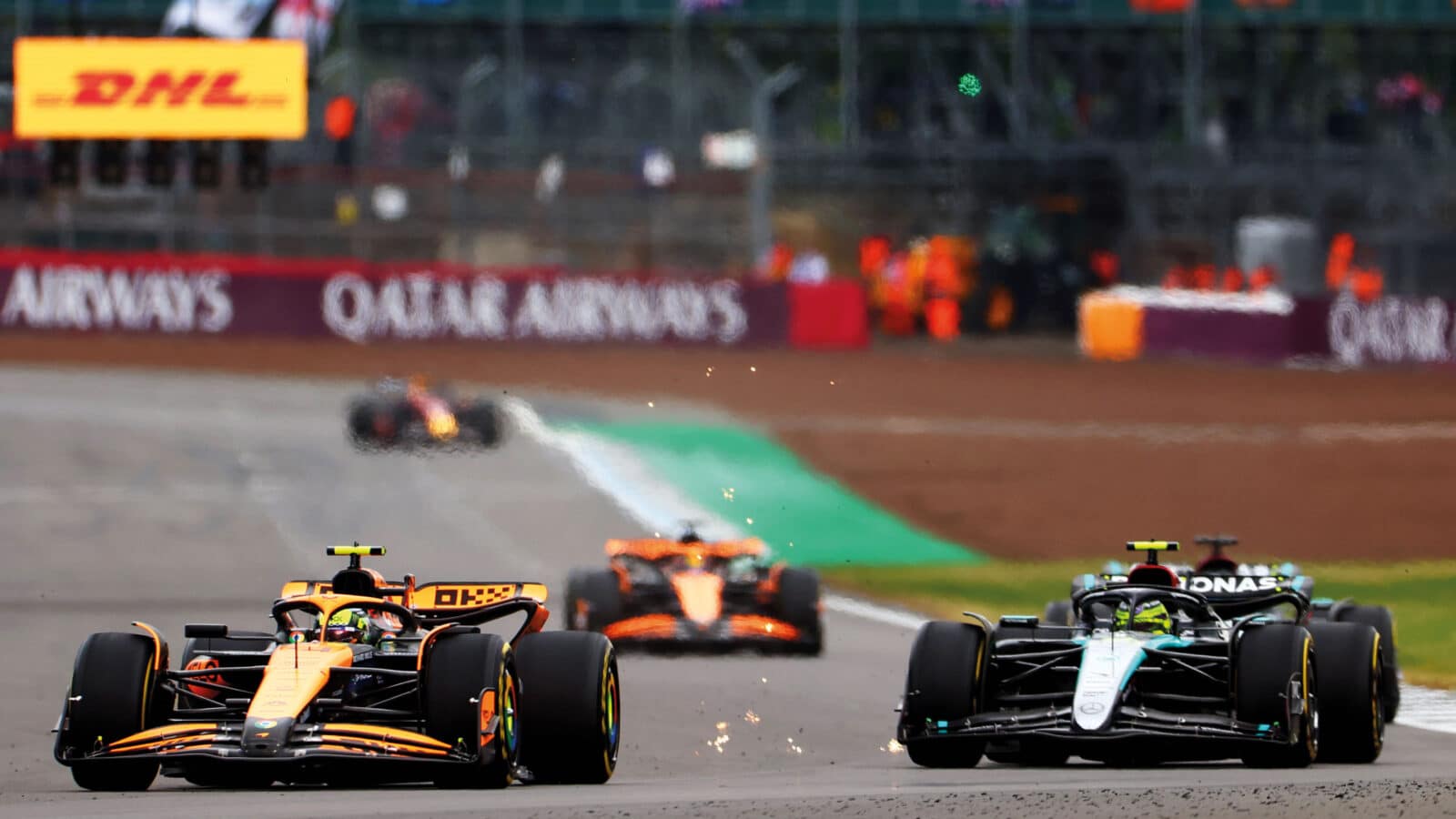
Max who? The Brits lit up Silverstone with Lando Norris, left, and Lewis Hamilton, right, giving the home crowd much to cheer about
Getty Images
The last three races before Formula 1’s summer break were a confirmation of the new competitive hierarchy, one in which McLaren was the team to beat after years of Red Bull domination. At Silverstone they were beaten and appropriately it was by Lewis Hamilton, ending his two-and-a-half-year win drought. It was a brilliant performance and his Mercedes was super-quick at key moments in the weather-affected race. But the victory depended upon McLaren making a couple of key tactical errors. Without those, Lando Norris and Oscar Piastri would surely have given the team a 1-2. McLaren would have to wait just two weeks to get that result though, Hungary marking Piastri’s first grand prix victory, with Norris following him home. But it was not without controversy. In the Belgian Grand Prix a more controversial Mercedes 1-2 followed, extending Verstappen’s non-winning sequence to four at a venue where last year he was setting consecutive victory records.
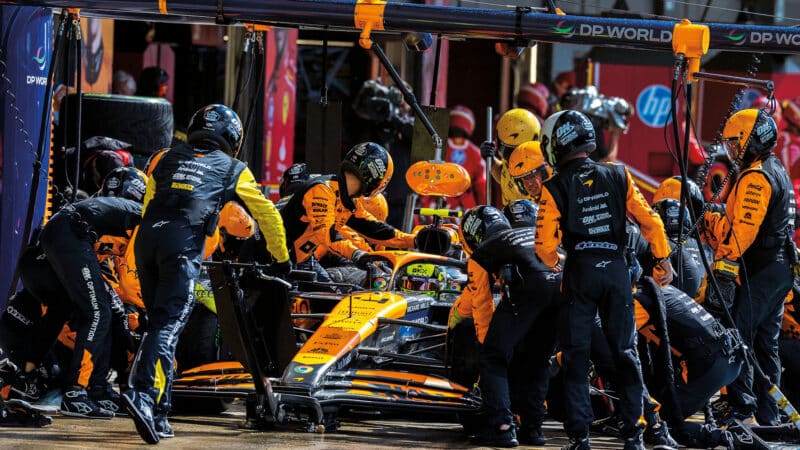
Norris lost time in a slow pitstop at the British GP.
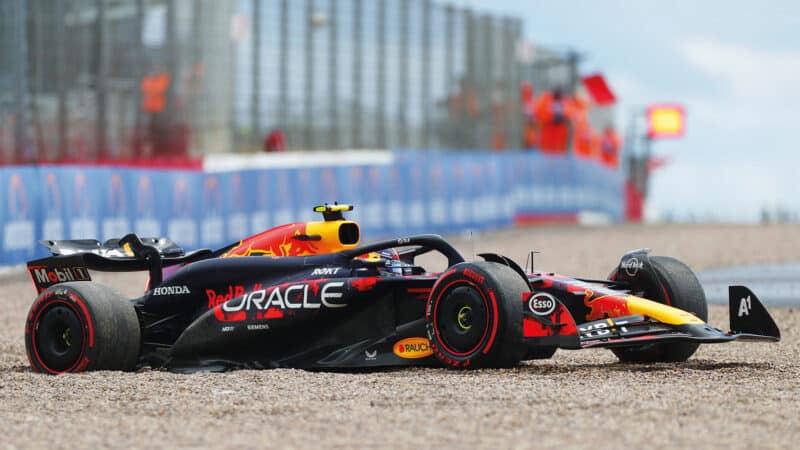
Sergio Pérez in the gravel in qualifying
Getty Images
Silverstone was a race energised by the changing weather. In qualifying a suddenly increased headwind through Brooklands and Luffield found George Russell’s Mercedes what it had previously been lacking to Norris’s McLaren, putting him on pole. He was helped by Norris having made a couple of key errors on his final lap – and this was enough for Hamilton to join his team-mate on the front row. A British driver 1-2-3 on the grid for the first time since the South African GP 1968 (Jim Clark, Graham Hill, Jackie Stewart), the first at the British Grand Prix since 1962 (Jim Clark, John Surtees, Innes Ireland). Verstappen was caught by a Copse crosswind in the damp Q1 and ran his Red Bull through the gravel, damaging a floor fence which inflicted further underbody damage downstream. With the car in this compromised form he could qualify only fourth.
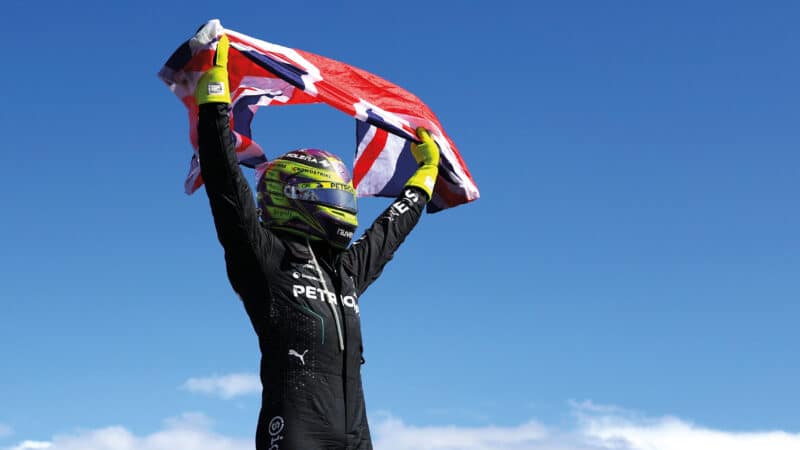
Be honest, did you ever think you’d see this sight again?
Getty Images
Russell and Hamilton led away to a roar from the crowd, with Verstappen initially prevailing over Norris but soon struggling to stay there. The Red Bull was just not on the pace of either Mercedes or McLaren and was passed into Stowe on consecutive laps by Norris and the other McLaren of Piastri.
A rain shower 19 laps in wasn’t heavy enough to demand intermediate tyres, but it did change the competitive picture. Hamilton, feeling more at ease on the slippery surface than Russell, sliced by him to take the lead into Stowe. But as both Mercs then ran wide onto the run-off area at Abbey a few corners later, they were pounced upon by both McLarens which were suddenly the fastest cars on track. Conditions seemed to have come to the aid of the bigger-winged McLarens as Norris now led from Piastri, Hamilton and Russell. The shower passed but still McLaren appeared to be in control of the race.
Except the weather changed things again. The second rain shower was heavier than the first and demanded a switch to intermediates. But getting the timing right was going to be crucial. Verstappen and Red Bull called it perfectly on lap 26. Norris and the two Mercedes drivers followed him in a lap later, Russell having to be stacked behind Hamilton and losing around 5sec. Piastri would have wished McLaren had decided to stack him. Leaving him out to do the extra lap on slicks on an increasingly wet track lost him 18sec and several places.
“With better choices McLaren could have taken a 1-2 at Silverstone”
Norris rejoined still leading, but now from Hamilton and Verstappen. Russell retired shortly afterwards with a loss of water pressure. This was shaping into a straight Norris vs Hamilton contest and as the track began to dry out Hamilton was closing on the McLaren. The Mercedes seemed faster in the dry, the McLaren in the wet. But it was all going to come down to timing of the move back onto slicks.
Within feasible undercut range of Norris, Mercedes brought Hamilton in on lap 38. Norris had been discussing with his engineer about coming in then too but had decided to stay out for an extra lap. It was the wrong decision, as was Norris’s choice to fit the same soft compound tyres as Hamilton when he had a new set of the superior mediums available (unlike Hamilton). A delay at Norris’s pitstop caused by him running past his marks after steering around the adjacent Ferrari mechanics lost him the lead to Hamilton. The soft tyres made him vulnerable to attack by the hard-tyred Verstappen – who deprived him of second place a few laps from the end.

The Hungarian GP saw a McLaren front-row lock-out – last seen at the 2012 Brazilian GP
DPPI
In managing his soft tyres perfectly in the last stint, Hamilton did enough to keep himself out of range of Verstappen and duly took his first victory since Saudi Arabia ’21. It also marked a record ninth Hamilton victory in his home race. Piastri in fourth place made up 13sec over Norris in the final stint, on account of having chosen the medium tyres. It all suggested that with better choices McLaren could have taken a 1-2.
McLaren set about putting that to rights at the Hungaroring two weeks later. There, the MCL38 was without question the fastest car in the place. Norris took pole by a few hundredths from Piastri. Verstappen was banging his steering wheel in frustration as he crossed the line half-a-tenth adrift of the papaya cars on his final Q3 run. It was the first McLaren 1-2 in qualifying since Brazil 2012. There were no team orders at McLaren but there was an agreement that whichever of them was ahead out of Turn 1 would receive strategic priority. Piastri made himself that man by getting down Norris’s inside, Norris the meat in the sandwich between his team-mate and Verstappen.
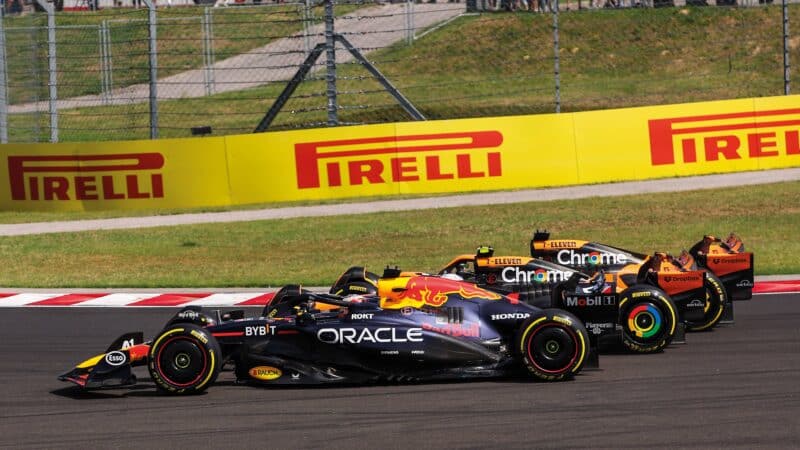
Norris, Oscar Piastri and Max Verstappen in a spot of Hungaroring choreography.
DPPI
Verstappen ran out wide onto the run-off and used his greater momentum there to rejoin ahead, the team subsequently advising him that he would need to give the place back. He did so grudgingly. At which point McLaren was running 1-2 once again. With significantly better race pace than the following Red Bull and the Mercedes of Hamilton, McLaren appeared to be in total control. It remained this way through the first pitstops, Piastri having built up a lead of 4sec over his team-mate. But he lost around 2sec of that advantage with an off-track moment at the fast Turn 11 on lap 33.
The set-up challenge of this generation of ground-effect cars as they have been developed to run ever-lower is to find a decent window between their low-speed understeer and high-speed oversteer. To combat the tendency for the front wings to become too effective at high speeds, generating instability at the rear, teams are developing very sophisticated mechanical systems to get rotation on their cars into slow corners. But the regulations require manual selection by the driver of the various settings. Piastri later said he understood what had happened at Turn 11 but remained otherwise tight-lipped. Upon seeing the 2sec time loss his engineer asked, “Is everything OK, Oscar?” The reply was a simple, “Yep.” He wasn’t up for explaining over the radio. Did he still have the slow corner setting as he went through the fast Turn 11? The oversteer snap which ran him wide was very sudden.
“The controversy diverted attention from Piastri’s maiden win”
But Piastri going wide onto the Turn 11 run-off had put in place the awkwardness which would follow at the second stops. Hamilton was at this time ahead in a battle with Verstappen and was close enough to be a very vague undercut threat to Norris as the second stops approached. In covering off that threat McLaren pitted Norris first in the full knowledge that this would undercut him ahead of Piastri – but with the intention then to revert the positions after Piastri rejoined (as per the strategic priority agreement for the driver ahead out of Turn 1). The idea was they’d then be free to continue racing. There were still no team orders.
But Norris’s speed upon rejoining had him pulling away from Piastri and showing very little inclination of handing the place back. The ensuing discussion over the radio with his engineer Will Joseph lasted several laps before Norris eventually acceded to the request three laps from the end. The controversy unfortunately diverted attention from the historic achievement of Piastri’s maiden grand prix victory in just his second season of F1. Hamilton retained his third place after seeing off a Verstappen challenge into Turn 1 which saw the Red Bull airborne, having interlocked wheels with the Mercedes.

Piastri’s first GP win – thanks to ‘strategic priority’
Having received his fifth power unit of the season coming into the Belgian Grand Prix, Verstappen would be taking a 10-place grid penalty. This was familiar territory for him, having won here at Spa from penalised grid positions in 2022 and ’23. However, with the recent form of McLaren and Mercedes he was far from confident he could make history repeat this time around. He was aided in his cause by qualifying being held on a wet track, his big-winged Red Bull and his own spectacular skills around this most demanding of circuits seeing him fastest by more than 0.6sec. This translated to 11th on the grid, with Charles Leclerc’s Ferrari starting from pole alongside Verstappen’s team-mate Sergio Pérez. Hamilton shared the second row with Norris ahead of Piastri and Russell.
Leclerc led away as Hamilton muscled his way by Pérez while Piastri again out-accelerated team-mate Norris off the line to go fourth. Running wide on the exit of La Source lost Norris a further two positions and that pretty much defined his race – unusually for Spa, overtaking proved to be very difficult. The DRS zone at the end of the Kemmel Straight into the usual overtaking spot of Les Combes had been shortened this year by 75m. It made a crucial difference. If you got caught in a DRS train it was extremely difficult to escape from it – as Verstappen also found. He ran the first stint behind Norris but in a long train headed by Pérez. “You end up just managing the temperature of your tyres and aren’t any faster than the cars around you,” summarised Verstappen after finishing a low-key fifth, one place ahead of Norris. The fight for the win would be elsewhere.
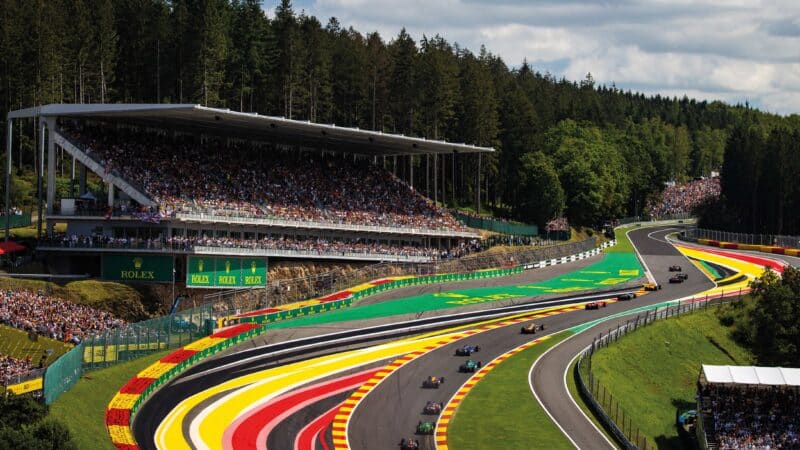
With Verstappen receiving a 10-place penalty at Spa, Ferrari’s Charles Leclerc led the field from the start.
Getty Images
Hamilton slipstreamed by Leclerc to deprive him of the lead on the third lap. In clear air the Mercedes was very strong and Hamilton seemed to have everything under control, the fast cars all at this stage stuck behind Pérez. Piastri managed to get past the Red Bull shortly after the first stops and he gradually began closing down the gap to Leclerc. Russell was next in line behind Pérez but was stuck there. He used the DRS from Pérez just to keep himself ahead of Verstappen who had undercut past Norris.
Russell’s race really only came to life as the cars ahead of him began peeling into the pits for their second stops. Piastri was the last of them to do it, leaving Russell in what was assumed would be a temporary lead. But the longer he went, the more certain he became that he actually didn’t need to stop again.
“Russell took what appeared to be a remarkable victory”
“Suddenly the tyres and car felt so good…” said Russell. “I was watching the big TV screens after Eau Rouge every lap and I could see they weren’t catching me as quickly as I was expecting. My lap times were improving and we were driving full gas around here and the track was getting faster and faster. The grip was improving all the time and the tyres were in a great state.
“But I was still questioning why no one else had done it. I thought, ‘I must be missing something here,’ because everyone’s peeling into the pits.
“It’s important to go with your gut but everyone pitted and the Friday data said a one-stop was not viable. I felt at one with the tyres and knew that would give me a bit of money back at the end. There are so many data points on the car, but as a driver you can feel how the car is sliding over the track; sometimes you gotta trust your gut.”

George Russell – disqualified
Getty Images
Hamilton – who’d stopped twice and whose tyres were 16 laps newer – arrived on his team-mate’s tail with just four laps to go. In Spa years past this would have been a slam-dunk DRS pass. That’s no longer the case. As Russell used his battery to defend in all the right places and concentrated on getting good traction out of La Source, Hamilton could do nothing about him. Piastri had earlier put a very committed pass on Leclerc by going around his outside into Les Combes. With a couple of laps to go he was right with the Mercs. Just one slip from them as they diced would have allowed him through, as he was clearly the fastest man on track.
But the Russell resolve held and he took what appeared to be a remarkable victory. It lasted less than an hour though. His car was found to be 1.5kg underweight, probably as a result of the more-worn tyres from the one-stop. There was no alternative but to disqualify. And so Hamilton inherited the win, incredibly his second in three outings, ahead of Piastri and Leclerc.
Pérez suffered another bad day at the office, finishing down in eighth from his front-row start and complaining that the Red Bull was impossibly hard on its tyres. As McLaren continued to take chunks out of Red Bull’s lead in the constructors’ standings – and Mercedes on form – his position was under serious review. His seat is safe, for now.


